It looks like you're using an Ad Blocker.
Please white-list or disable AboveTopSecret.com in your ad-blocking tool.
Thank you.
Some features of ATS will be disabled while you continue to use an ad-blocker.
share:
Here's an interesting question.
If no one has been on the moon except humans from this planet, can anyone explain the surface objects that I have rectangled in the image shown below?
A larger version and an unmarked version are available should they be required.

If no one has been on the moon except humans from this planet, can anyone explain the surface objects that I have rectangled in the image shown below?
A larger version and an unmarked version are available should they be required.

edit on 24-3-2013 by arianna because: text
Originally posted by arianna
can anyone explain the surface objects that I have rectangled in the image shown below?
They are called rocks. They are very common on the moon.
Originally posted by hellobruce
Originally posted by arianna
can anyone explain the surface objects that I have rectangled in the image shown below?
They are called rocks. They are very common on the moon.
Yes, there are plenty of rocks on this planet as well but what is it about these lunar objects that makes you think they are only rocks? have you studied the image detail carefully?
Originally posted by arianna
but what is it about these lunar objects that makes you think they are only rocks?
What makes you think that they are not rocks? have you studied them carefully?
Originally posted by arianna
Here's an interesting question.
If no one has been on the moon except humans from this planet, can anyone explain the surface objects that I have rectangled in the image shown below?
A larger version and an unmarked version are available should they be required.
Why are you asking about this low-resolution Hasselblad image (that you've adjusted to the point of near-uselessness) when I already directed you to 15 higher (in six cases, much-higher) resolution images?
I notice that your latest crop includes the pair of craters you asked about in this post
Originally posted by arianna
Here is a close view of the so-called 'obelisk'.
Personally, I do not think it is an obelisk. It is either a head statue or some form of communication device. Could it possibly be a parabolic reflector. What is of more interest are the objects showing in the nearer crater.
That's not a "close view". THIS is a close view:

The resolution is high enough to see individual boulders within each crater. I found it in less than a minute by checking the PanCam images in my post. This crop is from AS15-P-9021, but I also found the crater-pair in two other PanCam shots linked in my post.
Why are you "asking questions" (i.e. asking other people to do the work while you draw endless rectangles around random blobs) when you have already been given access to your answers? Is it that doing real research threatens to destroy cherished illusions? Right now, those illusions are holding you back. Each and every one of those 18 rectangles you drew is in areas well-covered by higher-resolution imagery. Others have checked those areas and moved-on. You could have done the same, by now.
It's a big moon and we've got a lot of ground to cover. Keep looking, but for goodness sake, use the material available to rule-out dead-ends and narrow-down your search.
reply to post by Saint Exupery
Well said, Saint Exupery. Where do you find these Apollo panoramic shots? I use wms.lroc.asu.edu... but there are only Metric Camera footprints. Also do you know of any of those panoramic shots where the lunar modules are visible?
Well said, Saint Exupery. Where do you find these Apollo panoramic shots? I use wms.lroc.asu.edu... but there are only Metric Camera footprints. Also do you know of any of those panoramic shots where the lunar modules are visible?
edit on 24-3-2013 by wildespace because: (no
reason given)
Originally posted by arianna
Here's an interesting question.
If no one has been on the moon except humans from this planet, can anyone explain the surface objects that I have rectangled in the image shown below?
A larger version and an unmarked version are available should they be required.
edit on 24-3-2013 by arianna because: text
I think, IMHO, it would be a lot better if you were to explain what it is YOU think you are seeing in those rectangles.
You are saying that there are "surface objects". That is rather vague. A rock or boulder is a surface object. Cliff faces, mountains and hills are surface objects. A crater can be a surface object.
If you are saying that they are not natural, but artificial, then what is it you think they are? Buildings? Roads? Light posts?
I know you've argued that using LRO images is not helpful because they are not oblique, however I do challenge that. Let me show why.
Here is a picture of Antarctica, that is oblique, from about the same altitude as the Apollo 8 pictures (around 30 miles are so):

Looks like there might be something interesting in the picture:
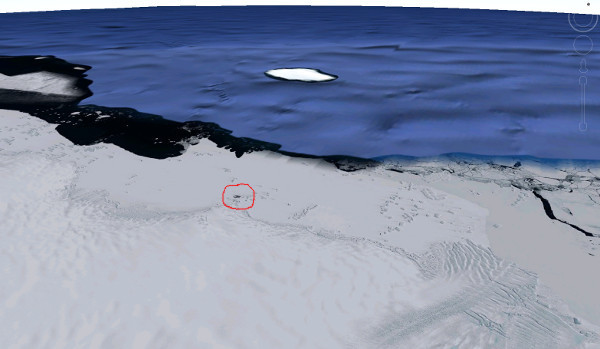
However, no mater how much I zoom in, and try to "enhance" this image with any photoshop program, all I'm going to see is something highly pixilated with no details at all. I can claim it's something artificial "to my trained eye", etc. But I don't think anyone else is going to agree.
Now, let us look at it as though it's been scanned by the LRO, and is a top down picture:
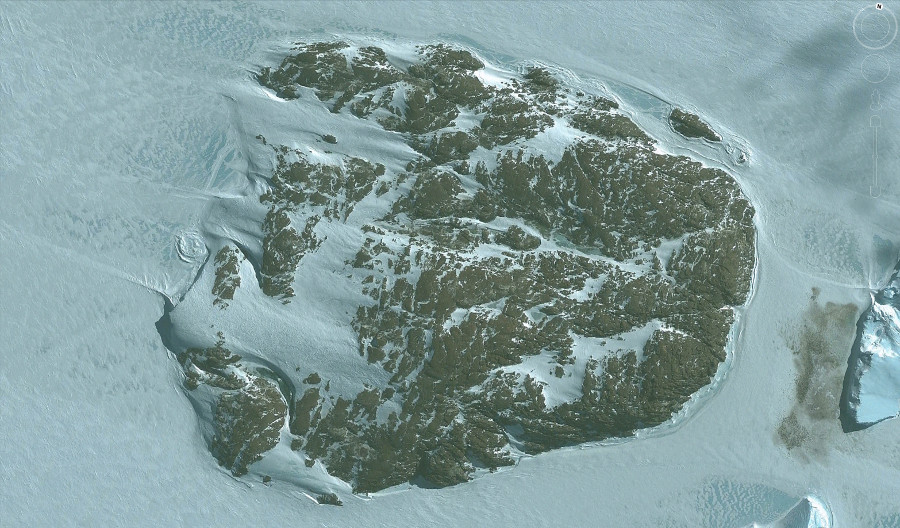
It's a rocky island. So nothing artificial. Completely natural.
And now, to show you something more. Go back up and look at the very first picture I posted. That blob I circled? Go about 1/2 a centimeter south of it. Do you see anything other than snow and ice? Zoom in that picture and you will get nothing more than pixilated snow and ice.
However, again, if I had a LRO image of the area at high resolution, and yes, even top down....here is what I would see:
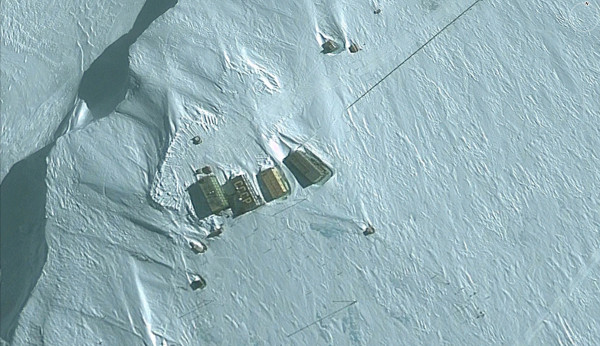
An old Soviet Union science station, complete with the letters CCCP on the roof of one of the huts......and even though it's top down, I can absolutely tell that this is artificial, not natural and is a structure.
Originally posted by eriktheawful
and even though it's top down, I can absolutely tell that this is artificial, not natural and is a structure.
That is the reason he does not want to use those type of pictures, they totally destroy his conspiracy theory!
Originally posted by wildespace
reply to post by Saint Exupery
Well said, Saint Exupery. Where do you find these Apollo panoramic shots? I use wms.lroc.asu.edu... but there are only Metric Camera footprints. Also do you know of any of those panoramic shots where the lunar modules are visible?edit on 24-3-2013 by wildespace because: (no reason given)
Before the LRO launched, Arizona State University was already working on The Apollo Image Archive. They started with the Metric (Mapping) Camera images, and finished scanning & uploading them years ago. When LROC images started coming in, they shifted their main effort to that. For a while, the AIA & LROC had separate image interfaces. Now they essentially use the same one (though each have different links).
ASU did not stop work on the Apollo images, but scanning the Panoramic Camera images has been a formidable task. Each 127x1219mm frame is scanned in 8 sections (called 'tiles') and each tile is a 1.9GB .tif file. I think they have completed the Apollo 15 & 16 scans, and they are available if you click on Browse Gallery from the Apollo Image Archive home page.
Apparently, due to the wide swaths covered by the PanCam images, it's difficult to show the swaths on the WMS image map (they had the same problem with oblique Metric images, which are also in the archive but not linked from the map interface). To make navigating the PanCam & oblique Metric images easier, I often use another site - The Apollo Image Atlas run by the Lunar and Planetary Institute. This site has scans that are lower-resolution, but well-organized. Crucially, it has a search function that, when you enter a feature or set of coordinates, will give you links to all of the Apollo orbital imagery of the desired area (that's how I put together my post on page 4 of this thread). Once I have the image numbers, I go to the Apollo Image Archive (those names aren't the least bit confusing, are they? ) and pull-up the hi-res versions with zoomable interface.
Spotting the Apollo LMs on the PanCam images is really tough They are right at the limit of resolution. Look for a lighter area of the regolith caused by the descent engine as they landed. Now look at the lighting: The sunlight is coming from the bottom of the frame, thus depressions (i.e. craters) are dark towards the bottom. A bump (such as the lander) will be bright towards the bottom, with its shadow at the top. The lander (which will be near the edge of the lighgtened patch of regolith) shows as little more than a bright pixel with a dark pixel over it. Here is AS15-P-9430. Good hunting!
(You can compare it to this LROC image to get a feel for how vastly-improved the image resolution is).
reply to post by wildespace
To wildespace, I fully appreciate what you are saying and I do have a good understanding of the LROC imagery. The problem is that I just cannot find a LRO top-down image of the area in question that is of good enough quality and resolution to pin-point the objects I have annotated in the zoomed-in Apollo oblique view.
To erik, If the quality of the LROC close view of the surface was as good as the quality seen in your image of Antarctica I would be more than happy to show the various objects in both views. i.e., the oblique Apollo version and the LROC top-down version of the same location.
To wildespace, I fully appreciate what you are saying and I do have a good understanding of the LROC imagery. The problem is that I just cannot find a LRO top-down image of the area in question that is of good enough quality and resolution to pin-point the objects I have annotated in the zoomed-in Apollo oblique view.
To erik, If the quality of the LROC close view of the surface was as good as the quality seen in your image of Antarctica I would be more than happy to show the various objects in both views. i.e., the oblique Apollo version and the LROC top-down version of the same location.
edit on 24-3-2013 by arianna because: (no reason given)
Originally posted by arianna
reply to post by wildespace
To wildespace, I fully appreciate what you are saying and I do have a good understanding of the LROC imagery. The problem is that I just cannot find a LRO top-down image of the area in question that is of good enough quality and resolution to pin-point the objects I have annotated in the zoomed-in Apollo oblique view.
To erik, If the quality of the LROC close view of the surface was as good as the quality seen in your image of Antarctica I would be more than happy to show the various objects in both views. i.e., the oblique Apollo version and the LROC top-down version of the same location.
edit on 24-3-2013 by arianna because: (no reason given)
While the area that you are pointing to doesn't have the same resolution as the old Soviet base, nor the island of rock, it does have a good enough resolution so that if there are things there: they would cast shadows from sticking up, or have shadows from being down.
In any case, it would behoove you to use more than one source, especially a more up to date source (to show changes if there are any).
Think about it for a minute: any serious science professional when researching something, take quite a bit of time to research what they are doing, and use multiple sources for those things before they ever think of publishing.
The reason for this is, just like here on ATS when you post something, they are going to have their fellow scientist put what they've published under a magnifying glass quite a bit.
We do the exact same thing here on ATS, on a multitude of subjects: UFOs, Moon pictures, Mars Pictures, Ancient Cultures stuff, even current events (politics, Earth's environment, etc).
Using different photos of the same area, taken with other sources besides Apollo (IE Clementine, LRO, etc), and if those photos help support what you think is there, use them. It will help your case more, and will give others more to look at and think about. You still won't get everyone to agree with you (not unless you produce something like my picture of the old Soviet Base, and even then you'll have people swear it's been photoshopped in), but it would help others on here take what you are showing more seriously, and not write it off so easily.
Originally posted by Saint Exupery
Spotting the Apollo LMs on the PanCam images is really tough They are right at the limit of resolution. Look for a lighter area of the regolith caused by the descent engine as they landed. Now look at the lighting: The sunlight is coming from the bottom of the frame, thus depressions (i.e. craters) are dark towards the bottom. A bump (such as the lander) will be bright towards the bottom, with its shadow at the top. The lander (which will be near the edge of the lighgtened patch of regolith) shows as little more than a bright pixel with a dark pixel over it. Here is AS15-P-9430. Good hunting!
(You can compare it to this LROC image to get a feel for how vastly-improved the image resolution is).
Thanks, and judging by that image, at least, it's actually very clear that the LM is there. You can even see the trampled soil nearby, matching the LRO image.
AS15-P-9430 at full zoom

LRO image
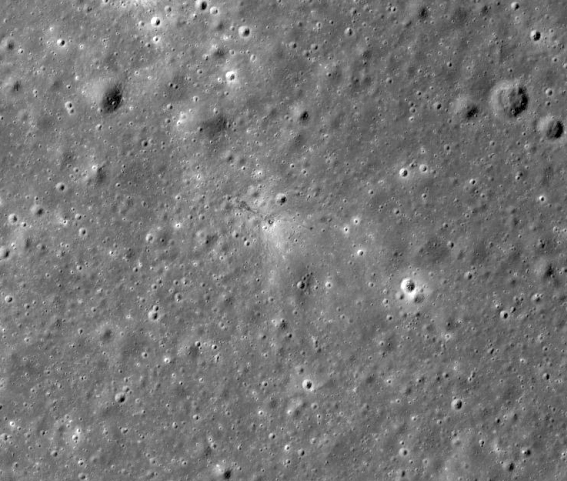
That makes it for interesting proof to present to hoax believers: not only LRO images show those sites and landers, but the Apollo crews photographed them from orbit too!
Originally posted by arianna
reply to post by wildespace
To wildespace, I fully appreciate what you are saying and I do have a good understanding of the LROC imagery. The problem is that I just cannot find a LRO top-down image of the area in question that is of good enough quality and resolution to pin-point the objects I have annotated in the zoomed-in Apollo oblique view.
There are plenty of hi-res LRO images covering that area. Here's one, for example, covering the area in the yellow square on your image: wms.lroc.asu.edu...
Here's a permalink for you that shows your area of interest with the LRO image "footprints" as red boxes: Click
Tick the box which says "Get Footprint Info", then click on any part of the map you want examined. You will get a pop-up window with any LRO NAC (narro-angle camera) images that cover that spot.
The image I originally used for the images shown above was the high-res .tif version of AS08-17-2744.
Would any member happen to know if there is .tif version for each of the other images in the series that covers this location? (2743, 2745 and 2746)
All I can find are the high-res jpg's which are not really clear enough to make a positive identification of the surface objects.
Thanks in anticipation.
Would any member happen to know if there is .tif version for each of the other images in the series that covers this location? (2743, 2745 and 2746)
All I can find are the high-res jpg's which are not really clear enough to make a positive identification of the surface objects.
Thanks in anticipation.
reply to post by arianna
You said this.
This is the gif you posted
Here is that area
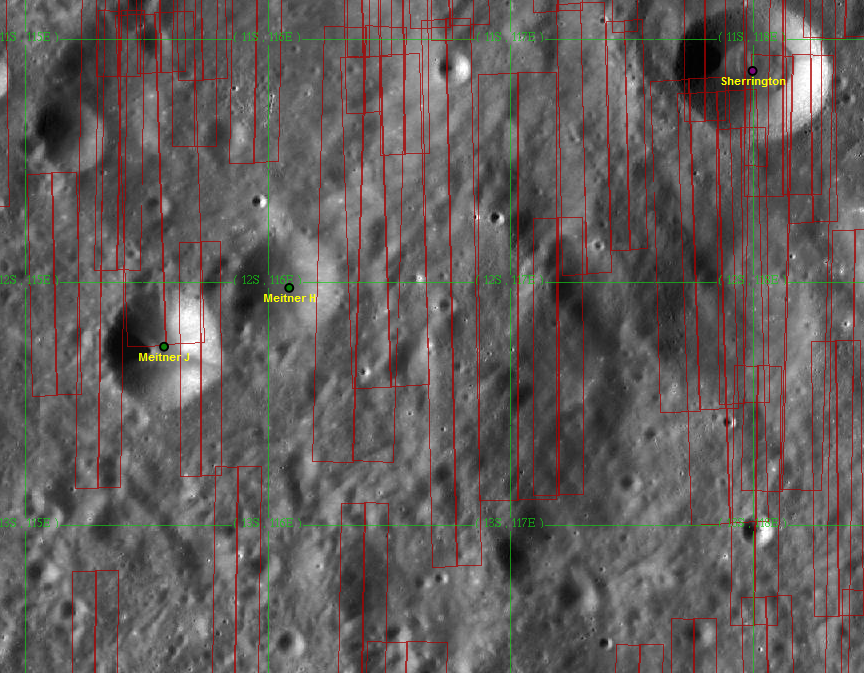
That was captured from Here that image is not at the full zoom level you can see the coordinates for the area of the Moon you can see the red boxes for the areas that the LRO has taken hi-res images so your challenge is look at one of your white dots from your picture find it on the LRO hi res image zoom in and lets see how many are craters at least one of your white dots will fall into one of the LRO images.
So now you have a chance to prove your claims!!!!
You said this.
Originally posted by arianna
The white dot showing at the top of the 'obelisk' is not part of it. In fact, there are many white dots showing in the view and other areas on the lunar surface so they cannot be shadows. If they are not shadows, what could the white dots be?
This is the gif you posted
Here is that area

That was captured from Here that image is not at the full zoom level you can see the coordinates for the area of the Moon you can see the red boxes for the areas that the LRO has taken hi-res images so your challenge is look at one of your white dots from your picture find it on the LRO hi res image zoom in and lets see how many are craters at least one of your white dots will fall into one of the LRO images.
So now you have a chance to prove your claims!!!!
Ariana,
Unfortunately AS08-17-2744 seems like one off, as there is no other tif scans of strips around 2744 that I could locate. Surprisingly archive.org has the best collection of high quality 50meg tif scans of Apollo hasselblads. They come with nice xml description file and are all worthy of download and investigation.
Unfortunately AS08-17-2744 seems like one off, as there is no other tif scans of strips around 2744 that I could locate. Surprisingly archive.org has the best collection of high quality 50meg tif scans of Apollo hasselblads. They come with nice xml description file and are all worthy of download and investigation.
Originally posted by arianna
The image I originally used for the images shown above was the high-res .tif version of AS08-17-2744.
Would any member happen to know if there is .tif version for each of the other images in the series that covers this location? (2743, 2745 and 2746)
All I can find are the high-res jpg's which are not really clear enough to make a positive identification of the surface objects.
Of course they're not clear enough to make a positive identification.
THE HASSELBLADS ARE THE LOWEST RESOLUTION APOLLO IMAGES AVAILABLE.
The Mapping Camera images have better than 10-times the resolution. The Panoramic Camera has over 100-times better resolution. The modern LROC images are more than 1,000 times better.
Why do you insist on restricting your search to only the most superficial material?
Why do you care what image somebody wants to look at? Why do you insist on yelling and screaming as if your mother was insulted in the process? I can
only laugh at your assumption that hasselblads are lowest resolution and therefore not as good as the other dataset. You are the one restricting
yourself if you do not include hasselblads in your investigation.
Originally posted by Saint Exupery
Originally posted by arianna
The image I originally used for the images shown above was the high-res .tif version of AS08-17-2744.
Would any member happen to know if there is .tif version for each of the other images in the series that covers this location? (2743, 2745 and 2746)
All I can find are the high-res jpg's which are not really clear enough to make a positive identification of the surface objects.
Of course they're not clear enough to make a positive identification.
THE HASSELBLADS ARE THE LOWEST RESOLUTION APOLLO IMAGES AVAILABLE.
The Mapping Camera images have better than 10-times the resolution. The Panoramic Camera has over 100-times better resolution. The modern LROC images are more than 1,000 times better.
Why do you insist on restricting your search to only the most superficial material?
reply to post by PINGi14
Of course the Hasselblad images aren't as good or are you like arianna avoiding using better images because they show whats really there.
Lets look at this image you posted I have put a red x next to a crater.
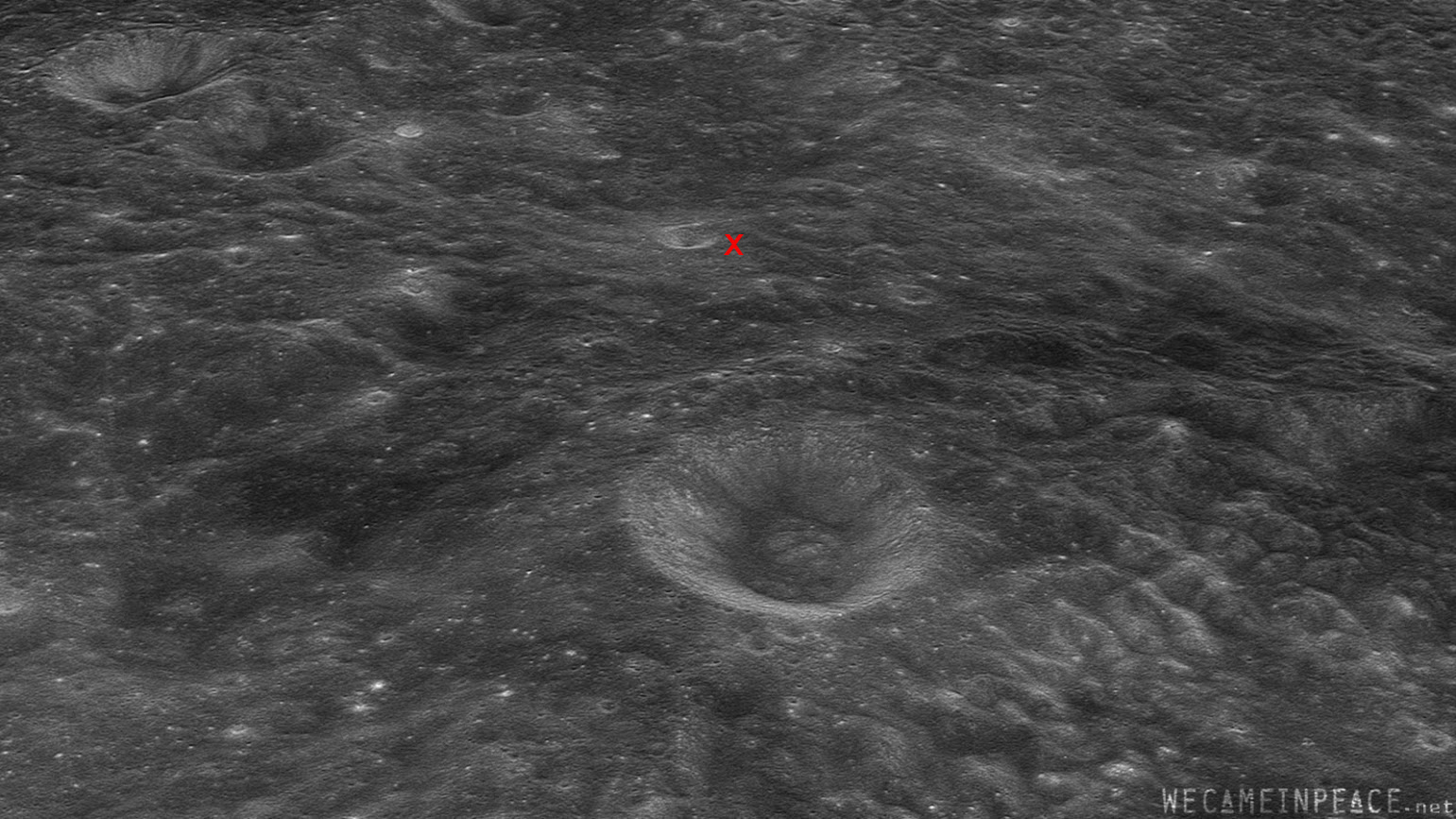
Now lets see that with the LRO image it's the bright crater to the left of Sherrington on this image.

Of course we can get a good bit closer with an LRO image.The image below is part of the southern rim of the crater on your image with the red x beside it, I have left the scale on the left to give you and idea of size this was not at full zoom .

Could you see those small craters on your Hasselblad image NO!!!
Now do you understand why in this case the Hasselblad images are of no use to confirm small surface features or any claims of so called structures.
Many of us on here are very VERY keen photographers even semi pro or pro we do know what we are talking about.
Of course the Hasselblad images aren't as good or are you like arianna avoiding using better images because they show whats really there.
Lets look at this image you posted I have put a red x next to a crater.

Now lets see that with the LRO image it's the bright crater to the left of Sherrington on this image.

Of course we can get a good bit closer with an LRO image.The image below is part of the southern rim of the crater on your image with the red x beside it, I have left the scale on the left to give you and idea of size this was not at full zoom .

Could you see those small craters on your Hasselblad image NO!!!
Now do you understand why in this case the Hasselblad images are of no use to confirm small surface features or any claims of so called structures.
Many of us on here are very VERY keen photographers even semi pro or pro we do know what we are talking about.
edit on 26-3-2013 by wmd_2008 because: (no reason given)
reply to post by wmd_2008
Why would you assume there aren't interesting things on lunar surface that are large enough in size to be resolved on Hasselblad photos taken by Apollo astronauts.
Why would you assume there aren't interesting things on lunar surface that are large enough in size to be resolved on Hasselblad photos taken by Apollo astronauts.
new topics
-
Famous Catholic Exorcist Visits Mir-a-Lago
US Political Madness: 4 hours ago
top topics
-
Famous Catholic Exorcist Visits Mir-a-Lago
US Political Madness: 4 hours ago, 5 flags -
Biden FINALLY allows Ukraine to use US missiles inside of Russia.
General Conspiracies: 12 hours ago, 0 flags
active topics
-
Well, here we go red lines crossed Biden gives the go ahead to use long range missiles
World War Three • 142 • : Lazy88 -
The Truth Behind the Manchester Airport "Police Assault" Video
Social Issues and Civil Unrest • 41 • : Oldcarpy2 -
Tomorrow will be the 7th day after the election, and they are still counting
US Political Madness • 45 • : PorkChop96 -
Racist Text Messages Mass Distributed
Social Issues and Civil Unrest • 30 • : WeMustCare -
Famous Catholic Exorcist Visits Mir-a-Lago
US Political Madness • 2 • : xuenchen -
Post A Funny (T&C Friendly) Pic Part IV: The LOL awakens!
General Chit Chat • 7783 • : baddmove -
Con Man Don
Jokes, Puns, & Pranks • 8 • : Moon68 -
POLLS - Leading Up To The November 2024 USA Elections.
2024 Elections • 323 • : NoCorruptionAllowed -
Former DOJ charged with defrauding Rep. Matt Gaetz’s family over sex-crimes investigation
Propaganda Mill • 25 • : fringeofthefringe -
The Change I Want To See
Rant • 64 • : doctordark

